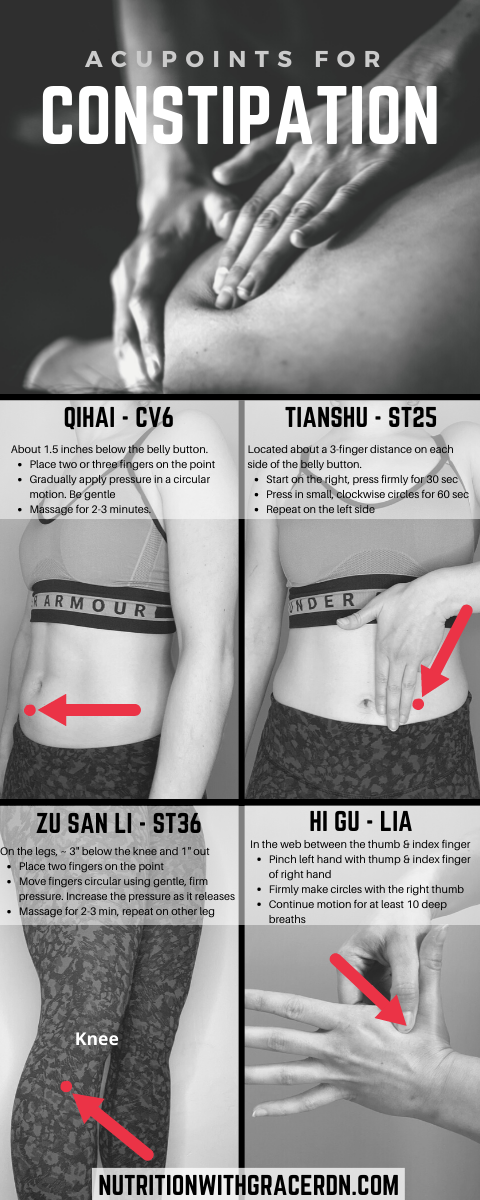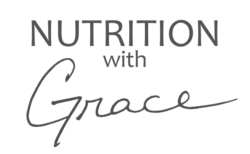table of contents
Constipation, especially chronic constipation, can be a life altering condition to live with. It may seem like small potatoes in the grand scheme of things, but I know from experience how it can consume your thoughts, actions, and decisions throughout the day.
I’m here to remind you that you are not alone. Our bowel habits are not something we like to talk about with our friends, coworkers or family members, but chronic constipation is extremely common. In fact, it is estimated to affect at least 24% of people in the US and Canada. (1)
The million dollar questions is what to do about it. I’m sure everyone has heard about laxatives, stool softeners, enemas, and even colonics, but what if you’re looking for a more holistic, non invasive way of treating your constipation?
If that sounds like you, look no further than the ancient Chinese practice of acupressure.
In this article, I’ll cover what chronic constipation and acupressure are, the research behind how and why it works, and how to stimulate pressure points for constipation on yourself.
Lastly, I will go over some other simple at-home constipation remedies that you can easily apply on your own.
What is Chronic Constipation?
It is difficult to find one, standard definition for chronic constipation because there are so many potential causes. However, a common definition states that chronic constipation is an intestinal disorder that can result in infrequent stools and/or difficult stool passage with pain and stiffness. (2)
As mentioned above, the reasons why a person experiences chronic constipation are complicated and multifactorial. Some potential causes include genetics, low socioeconomic status, low fiber intake, not drinking enough fluids, lack of movement throughout the day, a hormone imbalance, and a side effect of some medications. (2)
The risk of developing chronic constipation also increases with age. This is because older individuals are often not eating enough fiber, not drinking enough fluids, are less mobile, and are more likely to take medications that have constipation as a side effect. (2)
Treatment for chronic constipation depends on what’s causing it. The first line of defense is often simple lifestyle changes such as increasing fiber and fluids in the diet, paired with regular physical activity. If those don’t work, many people turn to laxatives and other medications to help stimulate a bowel movement. However, those treatment options can be harsh and cause uncomfortable side effects.
An alternative treatment option that has been researched and shown to be effective in many situations is the use of acupressure points for relieving constipation.
What is Acupressure?
Acupressure is an ancient Chinese practice that uses the principals of acupuncture without the needles. In short, it involves using fingers, palms, elbows, or feet to apply pressure to specific points on the body, which are referred to as acupoints. It can also involve stretching, acupressure massage, and other methods.
You’re probably wondering how it works.
Well, the theory behind traditional Chinese medicine (TCM) is that acupoints lie along 12 primary meridians (or channels) throughout your body. It is believed that these meridians connect specific organs to each other, which allows them to communicate with one another through the vital energy (referred to as qi – aka chi) that is flowing through them. According to this theory, illness occurs if one of these channels is blocked or out of balance.
This is where acupressure and acupuncture come in. They help to unblock the meridians and restore balance to the body.
Evidence on the effectiveness of stimulating pressure points for a variety of health conditions is still limited, however the current research is promising. Some conditions other than constipation that have shown positive responses to acupressure therapy are:
- Nausea/vomiting in pregnant women (3, 4)
- Nausea/vomiting after chemotherapy (5, 6)
- Improved sleep/insomnia (7, 8, 9)
- Headache (10)
What does the research say about pressure points for constipation?
The research is still young, but the effectiveness of acupressure for constipation has been studied using a variety of participants ranging from those with advanced cancer, to psychiatric patients, to elderly residential care home residents, to pregnant women and have shown promising results. (11, 12, 13, 14, 15, 16, 17)
There are many acupoints that are said to affect digestion, but stimulating even a few of them have been shown to improve symptoms of constipation. Four of the main ones include CV6 (Qihai), ST25 (Tianshu), ST36 (Zu San Li), LI4 (Hi Gu). (11, 13, 17)
How It’s Done
In general, acupressure is done by a trained practitioner. However, stimulating some acupoints on yourself has been shown to produce positive results. (13, 14) Here is the breakdown of how to apply pressure to the pressure points for constipation listed above:
CV6 – Qihai
This point is about 1.5 inches below the belly button.
What to do: (18)
- Find the point and place two or three fingers on it.
- Gradually apply pressure in a circular motion. Be gentle as this can be a sensitive spot.
- Massage for 2-3 minutes.
ST25 – Tianshu
There are two of these located about a 3-finger distance on either side of the belly button.
What to do: (19)
- Start with the point on the right side and press firmly for 30 seconds.
- Press in small, clockwise circles for another 60 seconds.
- Repeat on the left side.
ST36 – Zu San Li
This point is on the legs, about 3 inches below the knee and 1 inch toward the outer edge.
What to do: (19)
- Place two fingers on the point.
- Move fingers in a circular motion using gentle, firm pressure. Gradually increase the pressure as resistance releases.
- Massage for 2-3 minutes and repeat on the other leg.
LI4 – Hi Gu
This point is located in the web between the thumb and index finger.
What to do: (19)
- Pinch this point on your left hand with the thump and index finger of your right hand.
- Rotate the right thumb in a circular motion. Apply enough pressure to feel resistance but no pain.
- Continue motion for at least 10 deep breaths.

Are there any downsides?
Acupressure is generally considered safe. When performing it on yourself, it’s important to remember to use firm but gentle pressure that should never be painful.
There is a possibility to develop soreness or even bruises if too much pressure is used and please stop what you are doing immediately if you experience any pain.
Consult your healthcare professional before trying acupressure if you are pregnant or have any of the following conditions: (20, 21)
- Osteoporosis
- Recent bone fracture or injury
- Cancer
- Easy bruising
- A bleeding disorder
- Heart disease
- Uncontrolled high blood pressure
- Diabetes
- Prescriptions anticoagulant or antiplatelet medications (such as Coumadin/warfarin)
Other Home Remedies for Constipation
Looking for other ways to relieve your constipation that doesn’t involve harsh laxatives or invasive enemas? Look no further!
Try these 4 easy at-home remedies:
- Intestinal massage (22, 23, 24, 25)
- Drinking 75-100 oz water/day (26, 27)
- Increase daily fiber intake (28, 29)
- Try probiotics* (30, 31, 32)
- *Especially if you have IBS!
A couple of notes, for the fourth recommendation. The research shows that not all probiotics are created equal. In fact, the strain, dose and duration of time using the probiotic all play roles in how effective they are. Click here to learn more.
Final Thoughts
Constipation may seem like a minor condition, but those who experience it day-in and day-out know how much it can interfere with daily life. Fortunately, stimulating pressure points for constipation has been shown to be a minimally invasive treatment that can have a huge impact if administered appropriately. Remember, if you don’t feel comfortable stimulating your own acupoints, connect with an acupressure/acupuncture practitioner in your area.
As always, consult your healthcare professional if symptoms continue to discuss what might be the underlying issue or issues.
want this article?
download now, reference later!
jumpstart your journey to better gut health






